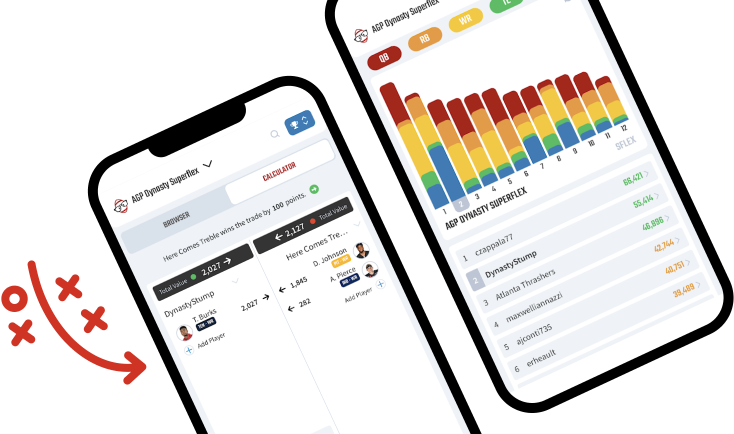Welcome back to the fifth season of the Fantasy Z-Score! A statistical blend of what metrics matter most in predicting future fantasy production.
I hope this model can provide you with actionable insight into each prospect’s profile, their pros and cons, and why it matters. The particular beauty of the Z-Score is in its transparency in the process, categorical grades, and final overall projection of PPG to satisfy those who are thirsting for a quick summary of the analysis, deep explanatory insight, and everything in between. Please scroll down to the “Method Behind the Madness” section for detailed explanations of the process and categories used.
Running backs are first, with Wide Receivers later in a separate article.
2023 Dynasty RB Rankings and Predictions
I’ve long been a fan of this class, even before the draft. I firmly believe the devaluation of the RB position in fantasy – specifically dynasty – will rebound much stronger than the current landscape suggests. And I believe that bounce starts with this class.
Below you will find each player’s Fantasy Z-Score rating, a snapshot of their profile grades, and their current consensus rookie ADP. A complete summary of the 2023 class all in one chart is included here for your viewing pleasure:

I’ll break down the running back tiers and methodology first.
Tier 1
1. Bijan Robinson (ATL)
Projected PPG: 18.6
Consensus Rookie ADP: RB1

Robinson is the clear-cut 1.01, and for a good reason. He achieved the extremely rare A+ Athleticism Score – which is a combination of combine testing (class-leading 108.7-speed score), broken tackle rate (an elite 33%), and dual-threat ability – to join the likes of Saquon Barkley and David Johnson as the only other two players to achieve such a feat. He also comes in with the highest film grade since Saquon Barkley. That’s twice now that we’ve compared him to the greatest RB prospect of our generation.
The cherry on top is an A grade for team-adjusted production, as anyone who can read a stat sheet already knows, and his premier lending spot with the run-heavy Falcons. Tyler Allgeier (a Z-Score sleeper last year) is coming off a 1,000-yard rookie season, so it remains to be seen how balanced they will approach their backfield, but Robinson will be the clear-cut leader regardless.
A gorgeous prospect profile that truly has it all means he can already be in the conversation for the dynasty RB1 overall, as crazy as that seems.
Tier 2
2. Jahmyr Gibbs (DET)
Projected PPG: 15.2
Consensus Rookie ADP: RB2

Drawing rave comps to Alvin Kamara across the fantasy community, Gibbs profiles the best receiving back in the class. Thirty-seven receiving yards per game and a 4.36 40-time emphasize what he can do in space as a receiver. His size hurts his Athleticism Score quite a bit, but his production, broken tackle rate (26% at Alabama is nothing to sneeze at), and film reviews more than make up for it. He might never be a three-down back like the good ole days, but an elite receiver is where the high-value touches lie.
Landing in Detroit as they ship out D’Andre Swift makes him nearly an exact replacement, with David Montgomery likely locked in for early-down and short-yardage roles. He controls the second tier of RBs in this class all to himself.
Tier 3
3. Zach Charbonnet (SEA)
Projected PPG: 13.1
Consensus Rookie ADP: RB3

Charbonnet grades with quite average athleticism, which is dragged down mostly by a concerning 23% broken tackle rate for a 214-pound RB. But his production is tantalizing for a big back, even more so his receiving work. He carries the size, production, and overall grades of one of the few remaining RBs who can work on all three downs.
Unfortunately, he lands in Seattle, where a very good back in Kenneth Walker already exists with a similar profile. One notable difference is that Charbonnet is a better receiver and could sprinkle in work at any distance. If there is one phrase that could sum him up, it would be “very solid.”
His final grade comes in just a bit behind Kenneth Walker (how ironic) from last year’s class for some perspective. Just think of less running power but more receiving prowess.
Tier 4
4. Devon Achane (MIA)
Projected PPG: 11.1
Consensus Rookie ADP: RB5

The notorious track sprinter captured the hearts of speed enthusiasts at the combine with his blazing 4.32 40-time. His production of 130 scrimmage yards per game in his final season is serviceable, but we would’ve liked to see more receiving work in college for a guy with his profile. A weight of 188 pounds will make it difficult to ever run inside a lot in the NFL, so we have to count on his utility usage and ability to break outside runs for big gains to capitalize on his upside. Thankfully he found refuge in perhaps the best possible schematic fit in landing with the Dolphins and McDaniels. They should be able to get the most out of his skillset, which was my number one hopeful landing spot for him. Sometimes dreams do come true. However, the film gurus gave him only an above-average film grade, so perhaps there’s more downside than meets the analytic eye. I’ll be drafting him at or slightly above cost since I expect the upper range of his outcomes.
5. Kendre Miller (NO)
Projected PPG: 11.0
Consensus Rookie ADP: RB5

An extraordinarily massive tier of “average starters” continues in this RB class. Many see this as negative, but I see it as a way to take advantage in rounds two or three of rookie drafts. A starting RB is worth a lot under the right circumstances. For example, David Montgomery, AJ Dillon, Kenneth Gainwell, Kareem Hunt, and Tarik Cohen have all graded as Cs in the past, yet have found favorable years or at least stretches of high fantasy relevance.
Miller’s far-and-away top trait is his ability to break tackles at a high level of competition. The rest of his profile is like a solid Charbonnet-lite profile but not great in many aspects. His landing spot is peculiar in New Orleans as his profile seems to match that of Jamaal Williams, and Alvin Kamara, pending his legal situation, will garner the lion’s share as long as he’s active. If I’m drafting Miller, I’m planning for either the 2024 season or extended missed time/performance decline from Kamara.
Tier 4 continued – with Spark Notes
6. Tank Bigsby (JAX)
- Got the draft capital and landing spot to be an immediate contributor
- Size and broken tackle rate should solidify his early down “grinder” role
- Below-average production and football athleticism
7. Deuce Vaughn (DAL)
- My personal favorite sleeper RB of the class. #SmallButMighty
- Outstanding production at a higher level of competition
- Horrifically tiny (179 lbs) with TD ceiling concerns
- Disappointing film grades
8. Eric Gray (NYG)
- Above average in nearly all metrics – was forecasted to be drafted a bit higher
- Has the size and skill set to be a large role back if Barkley leaves or is injured
- He’s behind Barkley for at least a year, and low draft capital won’t solidify his usage
9. Tyjae Spears (TEN)
- Nice receiving chops to compliment Derrick Henry
- Could’ve been RB4/5 in class with a better landing spot
- Notable injury concerns, behind Henry for at least a year
Honorable Mentions
12. Sean Tucker (TB)
- Best landing spot available to make a splash
- If injury concerns are overblown, he could have a surprise breakout later in the year
16. Zach Evans (LAR)
- We knew he was overvalued pre-draft, and draft capital confirmed
- Beautiful landing spot to carve a role next to Cam Akers if he can
The remaining backs can be found in the overall chart listed above, and their projections can give you an idea of what to expect.
Method Behind the Madness – Running Back Section
The Z-Score always aims to use the best of the best as it pertains to metrics, constantly trying to identify new methods to improve its predictability. I run a correlation to NFL PPG every off-season to make sure the metrics are staying relevant or being eliminated from the equations.
However, the RB Z-Score has had very few blemishes or misses in the past few years. As a result, very few changes have been made to this year’s model. The most important is the Film Grade being expanded from Lance Zierlein grades from NFL.com to a collective film grade with DynastyNerds Nerd Score, and others included.
Below you will find each category, followed by a short explanation of their use.
Draft Capital
- By pick placement
Lack of Backfield Fantasy Competition (Landing Spot)
- How many PPG are being scored by existing team RBs?
- Measures short-term opportunity at the time of publishing
- Weaker competition translates into more touches for incoming rookies
Athleticism Score
- Average of Combine Metrics
- Harvard Combine Metric
- MLR of recent combine results to NFL PPG
- College ability as a dual-threat in rushing and receiving
- Broken Tackle Percentage *adjusted for opponent strength SOS*
Film Grade (aggregated from three film sources)
- Correlated historical film grades from three sources, including DynastyNerds Nerd Score, into expected fantasy points per game.
College Production Adjusted For Competition – Final Season
- Fantasy Points Per Game
- Team SRS (Simple Rating System)
- Team SOS (Strength Of Schedule)
- Receiving Yards Per Game
Each final letter grade is representative of what echelon of PPG that player falls into. (E.g., a 95% or better Athleticism Score as an A+). Please follow the Twitter links above for more detailed explanations of each category.
NOTE: Many of these sections have not changed from the previous year’s articles, as their effectiveness remains unchanged and strong.
Breaking down each category, we can understand their usefulness. Draft capital is self-explanatory. The higher the selection, the better the player likely is and the more investment from the team to ensure they succeed.
Next is lack of fantasy competition – aka immediate opportunity available. It can show us who has an immediate chance of success in their rookie year and early career. A team without a clear-cut leader is more likely to give opportunity to their brand new rookie.
Athleticism Score is what I defined as football athleticism as it relates to fantasy production. This consists of the Harvard Combine Metric and MLR of combine data, broken tackle percentage (courtesy of Sports Info Solutions), and their ability to work in both the rushing and receiving game in college as a dual threat. All of these correlates strongly to fantasy and, as a whole, are toe-to-toe with draft capital for relevance.
Film grades have been a nice balance to the Z-Score, giving pure analytics and pure film their respective weights. Film analysts from NFL dot com, DynastyNerds, and others have shown that their work is becoming as reliable as draft capital as the years go by. The film grade in the Z-Score is a unique weighted blend of these grades so as not to become pigeonholed into one single group’s way of seeing a player’s potential on film. Sure enough, the combination of all three has shown stronger predictive power than any one. This adds confidence to the metric, knowing it is only included the best by balancing each other out when needed and amplifying it when all align to see the same result.
Another big year incoming for the #NERDSCORE by @DynastyPrice & @JaredWackerly.
— David Zäch (@DavidZach16) April 25, 2023
Solidifying its way into the elite company of film graders with the likes of NFL . com's Lance Zierlein & ESPN's Scouts Inc after only a few years… and only getting better🔥
WRs left – RBs right pic.twitter.com/0eDuEC2mir
College Production Adjusted For Competition was an idea first brought to my attention and pioneered by Underdog analyst Hayden Winks to adjust production for how strong a team was and how strong the competition they faced was. I used a multiple linear regression model involving the four variables I found to carry the highest significance (low p-values) to fantasy which consisted of college FPPG, receiving yards per game, and SportsReference metrics SRS (Simple Rating System) and SOS (Strength of Schedule). You can find Hayden on Twitter @HaydenWinks for some great analytic threads on the incoming rookies and more.
What makes all of the stats mentioned above important enough to include? They all have correlated strongly to PPG over the last seven years. Draft capital itself has a historical R-squared of 0.41 to three-year PPG in my database. The Fantasy Z-score sits at 0.56; which means we are beating out draft capital and the consensus fantasy industry ADP.
Look at the previous year’s comparisons, especially when compared against ADP. You can clearly see the advantage this process gives us with proven results.
Thanks for reading, and stay golden! If you like what you learned, follow me @DavidZach16 for more interesting stats and tidbits throughout the year. You can also find full 2023 projections for all teams and players under my Twitter profile pinned link: “Freaks In The Spreadsheets” PDF fantasy guide.








